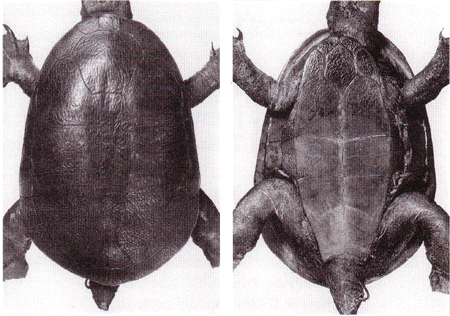The identification of the holotype of Chelodina oblonga (Testudines: Chelidae) with a discussion of taxonomic implications. Chelonian Conservation and Biology. 3(4):745-748
Scott A. Thomson
Applied Ecology Research Group and CRC for Freshwater Ecology, University of Canberra, Canberra, ACT 2601, Australia
For a stable nomenclature to develop within any group of species it is important that common usage is justified by accurate identification of holotypes. Unfortunately it occurs at times that the holotype represents a species that is not the same as that to which the name has been applied for a considerable time. When mistakes are found corrections should be made in accordance with the rules and guidelines of the International Code of Zoological Nomenclature (ICZN, 1999).
|
In addition he assigned turtles subsequently collected in Port Essington, Northern Territory, to his concept of C. oblonga (Gray 1844, 1856b, 1873). However, C. colliei was later synonymised under C. oblonga by Boulenger (1889) and has not been recognised as distinct since then. Later C. rugosa (from "Cape York") and C. siebenrocki (from "Deutch-Neu-Guinea") were also synonymised under C. oblonga by Siebenrock (1909, 1915). This usage persisted in most Australian literature for the next half century, with all similar-appearing long-necked turtles from northern and western Australia referred to as C. oblonga. (eg Worrell, 1963). However, Mertens and Wermuth (1955) and Wermuth and Mertens (1961) resurrected the New Guinea species C. siebenrocki from the synonomy of C. oblonga, and Goode (1967), recognising that northern Australian long-necked turtles were in fact very similar to the New Guinean C. siebenrocki, then utilised that name (erroneously ) for the northern Australian form and restricted usage of the name C. oblonga to the southwestern Australian form from Perth. Cogger and Lindner (1974) and Burbidge et al. (1974) then corrected Goode's usage by resurrecting the earlier name C. rugosa instead of C. siebenrocki for the northern Australian form. |

Figure 1. Dorsal and ventral views of the holotype of Chelodina oblonga (BMNH 1947.3.5.89). |
Since then major field guides such as Cogger (1975, 1979, 1983, 1985, 1992), checklists and catalogues such as Iverson (1985, 1992) and Cogger et al. (1983) and numerous journal papers have utilised the name C. rugosa for the northern Australian form. Chelodina siebonrocki, if valid at all (it may be synonymous with C. rugosa), is restricted to New Guinea (Rhodin and Mittermeier, 1976).
|

